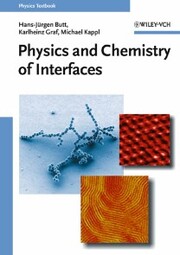Detailansicht
Physics and Chemistry of Interfaces
eBook
ISBN/EAN: 9783527606405
Umbreit-Nr.: 3836006
Sprache:
Englisch
Umfang: 373 S., 8.13 MB
Format in cm:
Einband:
Keine Angabe
Erschienen am 06.03.2006
Auflage: 1/2006
E-Book
Format: PDF
DRM: Adobe DRM
- Zusatztext
- Serving as a general introduction to surface and interface science, this book focuses on basic concepts rather than specific details, and on intuitive understanding rather than merely learning facts. The text reflects the fact that the physics and chemistry of surfaces is a diverse area of research that involves classical scientific and engineering disciplines. As such, it discusses fundamental subjects, such as thermodynamics of interfaces, as well as applied topics including wetting, friction, and lubrication.<br> Following an introduction to the most important techniques and methods, readers will be able to apply simple models to their own scientific problems. Furthermore, manifold high end technological applications are shown together with the basic scientific treatment, for example AFM, surface technology, biotechnology, microelectronics, and biomaterials.<br> The book is written with advanced students of chemistry, physics, materials science, chemical engineering and related subjects who have a basic knowledge of natural sciences and mathematics in mind. In addition, scientists and engineers who are not yet specialists in surface science but want to learn more about this important subject will equally benefit.
- Kurztext
- Serving as a general introduction to surface and interface science, this book focuses on basic concepts rather than specific details, and on intuitive understanding rather than merely learning facts. The text reflects the fact that the physics and chemistry of surfaces is a diverse area of research that involves classical scientific and engineering disciplines. As such, it discusses fundamental subjects, such as thermodynamics of interfaces, as well as applied topics including wetting, friction, and lubrication. Following an introduction to the most important techniques and methods, readers will be able to apply simple models to their own scientific problems. Furthermore, manifold high end technological applications are shown together with the basic scientific treatment, for example AFM, surface technology, biotechnology, microelectronics, and biomaterials. The book is written with advanced students of chemistry, physics, materials science, chemical engineering and related subjects who have a basic knowledge of natural sciences and mathematics in mind. In addition, scientists and engineers who are not yet specialists in surface science but want to learn more about this important subject will equally benefit.
- Autorenportrait
- <b>Hans-Jürgen Butt</b> studied physics at the Universities of Hamburg and Göttingen, Germany. Then he went to the Max-Planck-Institute of Biophysics in Frankfurt. After receiving his Ph.D. in 1989 he went as a postdoc to Santa Barbara, California, and learned using the newly developed atomic force microscope. From 1990-95 he spent as a researcher back in Germany at the Max-Planck-Institute for Biophysics. In 1996 he became associate professor at the University of Mainz. Three years later he moved to Siegen to become full professor for physical chemistry. Only two years later he joined the Max-Planck-Institute of Polymer Research in Mainz.<p><b>Karlheinz Graf</b> studied chemistry at the universities of Erlangen and Mainz, Germany. After receiving his Ph.D. in Physical Chemistry in 1997, he went as a postdoc to Santa Barbara, California working on physicochemical aspects of myelin and lung surfactant. Back in Mainz he investigated nanostructured lipopolymer films. Scince 2001 he is working on model systems for microsystem technology in the group of Prof. Hans-Jürgen Butt at the Max-Planck-Institut for Polymer Research and the University of Siegen.</p><p><b>Michael Kappl</b> studied physics at the University of Regensburg and the Technical University of Munich. He finished his PhD at the Max-Planck-Institute of Biophysics in Frankfurt/Main in 1996. From 1997 - 1998 he did one and a half years of postdoctoral research at the University of Mainz in the group of Prof. Butt. From 1998-2000 he worked as a IT consultant at Pallas Soft AG, Regensburg. In 2000, he rejoined the group of Prof. Butt at the University of Siegen. Since end of 2002 he is project leader at the MPI for Polymer research in Mainz.</p>
